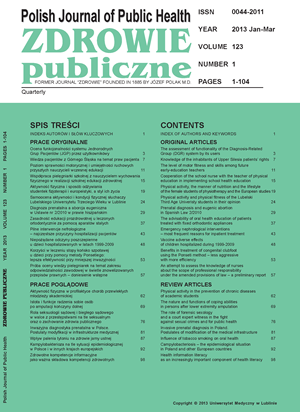Ocena funkcjonalności systemu Jednorodnych Grup Pacjentów (JGP) przez użytkowników
DOI:
https://doi.org/10.12923/j.0044-2011/123-1/a.01Słowa kluczowe:
JGP, gruper, funkcjonalnośćAbstrakt
Wstęp. Autorami systemu opartego na grupowaniu przypadków, w zależności od rodzaju diagnozy i wykonanych procedur byli Robert Barclay Fetter i John Deve-reaux Thompson z Yale University. Po raz pierwszy DRG wdrożono w New Jersey na początku 1980 r. a w 1987 r. decyzją władz stanu Nowy Jork DRG stało się podstawą do rozliczania pacjentów. W Europie model rozliczeń oparty o DRG obowiązuje prawie we wszystkich krajach Unii Europejskiej z wyjątkiem Czech i Słowenii. W Polsce system został wprowadzony w lipcu 2008 r. co wywołało liczne kontrowersje w związku ze zmianą finansowania usług zdrowotnych
Cel. Celem pracy była ocena przydatności funkcji grupera JGP przez użytkowników.
Materiał i metody. Badanie przeprowadzono przy użyciu ankiety na grupie 200 szpitali w lutym 2009 roku. Udział użytkowników systemu w badaniu był dobrowolny. Ankiety wypełniło 14% wszystkich użytkowników. Uczestników badania podzielono na następujące grupy zawodowe: lekarze, sekretarki medyczne w oddziałach, pracownicy działu statystyki medycznej/rozliczeń z NFZ, inni.
Wnioski. Zebrane dane zostały opracowane statystycznie. Otrzymane wyniki wskazują na największą przydatność funkcji grupowania pobytu natomiast za najmniej przydatne użytkownicy uznali analizę czasu pobytu. Można stwierdzić bardzo podobny rozkład przydatności funkcjonalności gupera we wszystkich 4 grupach badanych. Wyraźnie widać, że użytkownicy wykorzystują oprogramowanie głównie do prawidłowego wyznaczenia grupy JGP, a znacznie rzadziej dokonują optymalizacji kodowania
Bibliografia
1. Diagnosis-related group. http://en.wikipedia.org/wiki/Diagnosis-related_group
2. Medicare (United States). http://en.wikipedia.org/wiki/Medicare_(United_States)
3. Centers for Medicare and Medicaid Services (CMS); http://www.cms.hhs.gov/
4. Komunikat z dnia 9.05.2008 r. Departament Świadczeń Opieki Zdrowotnej NFZ. www.nfz.gov.pl
5. Komunikat z dnia 27.03.2009 r. Departament Świadczeń Opieki Zdrowotnej NFZ; www.nfz.gov.pl
6. Misińska B. Jednorodne Grupy Pacjentów na Dolnym Śląsku – próba rekonstrukcji. Menedżer Zdrowia. 2008;4:16-8.


